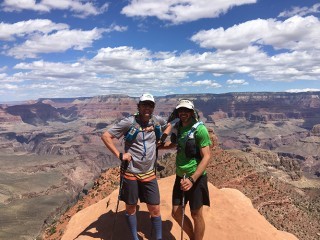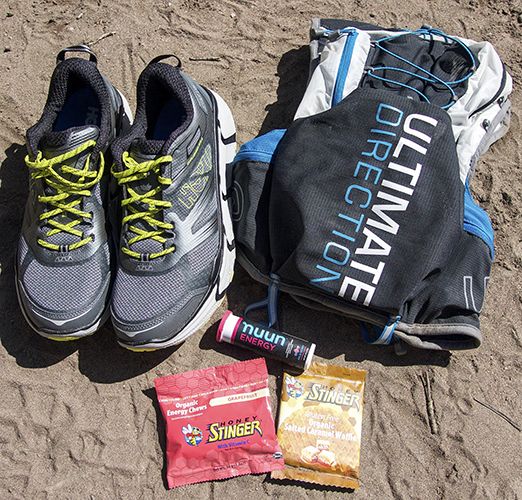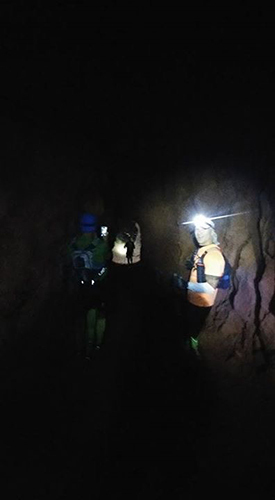Photos: Taking the Challenge of Running the Grand Canyon Rim-to-Rim-to-Rim

This is what ultrarunning pain feels like.
I’m practically staggering up the North Kaibab trail somewhere in the bottom of the bottom of the Grand Canyon. We set out early this morning to complete the epic rim-to-rim-to-rim adventure run at 3:30 a.m. Now 33 miles into the day, the sun and 85-degree heat is leeching our strength, and we’re facing down the crux: 5,500 feet of climbing over 10 miles until we reach the safety and comfort of our campsite atop the North Rim. The confidence we felt an hour earlier has evaporated into crashed out exhaustion. R2R2R is a famous ultrarunning test piece, but getting out in one piece is all that matters.
Dammit. I just ran out of water, with several miles of desert separating us from the next potable source at Cottonwood Campground.
As a sense of panic joins the fatigue, we turn a corner to find a creek flowing across the trail from a side gorge. I practically dive for it. Pack and various contents are strewn about in the muddy grass. I notice a camouflaged frog two feet away as I dunk my head and start guzzling.
All this madness began with a text back in early April from long-time friend and veteran ultrarunner, Brian Metzler, the editor-in-chief of Competitor.
“R2R2R on May 21?”
I consider the stats. 45 miles and 22,000 feet of elevation change in a single push that would likely take 12 to 14 hours. This would be my biggest run ever, my base fitness is inadequate, and the Grand Canyon is notoriously sadistic.
“I’m in!”
[Editor’s note: Running in the Grand Canyon is a serious undertaking, no matter the distance or the time of year. Be sure you’re properly trained, have the proper gear and know how to re-fuel effectively.]
RELATED: A Runner’s Guide to Conquering the Grand Canyon
Photo Gallery
1 of {count}
Back to Start
View Larger Image

On the Road to the North Rim
A month flies by, and, after packing in as much training as possible, suddenly it’s go-time. Juggling family and work schedules, we’re packing all the action into three days. Known for relentless energy, Brian is driving from Boulder, Colo., to the Grand Canyon in one 702-mile day, stopping along the way to grab me in Glenwood Springs. We’ll be at the North Rim by evening, allowing a few hours to shake out before an early start the next day.
View Larger Image

A Toast to the Next Day's Adventure
We arrive, suddenly immersed in the iconic National Park vibe of the North Rim. After setting up camp, we get our first look at the Canyon from the Transept Trail walking to dinner at the rustic Grand Canyon Lodge. It feels like we’ve stepped back in time to the ‘20s.
Our table sits next to a massive window through which we can see the South Rim many miles across. We’re quiet as reality sets in. Holy shit, we’re running there and back tomorrow.
The forecast looks favorable. Partly cloudy, windy, and cool at the upper elevations. Highs in the low 80s near the river.
View Larger Image

Mandatory Gear
Time to prepare for a big day on the trail. For me, that meant wearing a pair of Hoka One One Challenger ATR 2 and Ultimate Direction's PB Adventure Vest 3.0 and fueling on Honey Stinger Gluten Free Organic Salted Caramel Waffles and Honey Stinger Energy Chews. Essential gear in the pack included an Outdoor Research Helium II shell and a Black Diamond Revolt headlamp. Last, but not least, a pair of Leki Trail Stick collapsible carbon-fiber trekking poles would be crucial to my success.
View Larger Image

An Early Start
The alarm sounds at 2:30 a.m. Laced up, packs snug and we’re at the North Kaibab trailhead, already a hub of industry as runners and hikers converge to plunge into the abyss. We set off down the trail, cruising steep switchbacks through the ponderosa pine forest that thrives at 8,000 feet.
A spiritual convocation is delivered a few minutes later when we encounter a Mexican Spotted Owl. Illuminated by our headlamps at eye level, the bird spreads its wings, reveals the compact strength of a raptor, and hovers for a moment sizing us up. We feel the majesty of this creature and its home.
Numerous stretches of the North Kaibab trail were created by blasting it from limestone cliffs. At two miles, we hit the Supai Tunnel.
View Larger Image

On the Trail to Find Out
Temps are perfect as we descend through Pinyon-Juniper woodland. Water comes easily with four potable sources in seven miles. We fill flasks and leave bladders empty in our packs. Suddenly, we’re in the Desert Scrub ecosystem, running smoothly with the gentle gradient.
View Larger Image

Here Comes the Sun
As day breaks, the ancient Vishnu Schist of the Inner Gorge swallows us. After 11 miles, I feel the first twinge of tiredness in the legs. A little voice whispers, “It’s gonna be a lot harder and hotter next time you pass through here.”
“Yeah, whatever. This is the coolest trail run I’ve ever done!”
View Larger Image

Phantom Ranch Fill-Up
We reach Phantom Ranch and the mighty Colorado River around 6:30 a.m. This oasis on Bright Angel Creek is teeming with hikers, runners, and the Grand Canyon’s famous mules. We re-fill up our hydration packs and consume some calories, knowing the next 3 hours up South Kaibab Trail will be hot and hellacious.
View Larger Image

Crossing the River
The idyllic dawn will soon yield to blazing sun on the exposed and water-less South Kaibab trail. We fill up, cross the suspension bridge over the river, and set out on the second stage of the journey.
View Larger Image

Up on South Kaibab
Buoyed by non-stop scenic awe, the climb up to the South Rim goes amazingly well. It's a grind and pretty hot where it's totally exposed, but we are efficient, careful to stay aerobic during the 4,900-foot, 7-mile ascent.
The first real blast of fatigue hits us 20 miles into the day, with two long sucker miles to go before reaching our halfway point.
As we climb above 5,000 feet, high clouds and a stiff, cool breeze minimize attrition. We top out. Fist bumps. Halfway, baby!
We re-fill our hydration packs again, take in some more snacks and quietly acknowledge that it's about to get real on the way back down South Kaibab.
View Larger Image

The Doom of the Downhills
Descending South Kaibab is where the beatdown begins. Adios to that smooth cadence you found on the way up. The trail is steep with thousands of rutted steps that mercilessly pummel knees, hips and quads. We try in vain to find a biomechanically friendly stride pattern as the sun starts to take its toll.
A 1 p.m., we're back across the river and into Phantom Ranch during the heat of the day. We are feeling pretty good and treat ourselves to water and food in the shade. “It’ll be harder if we wait around, so let’s hit it.”
Just four miles later, I’m a mess—collapsed by the creek that we must have skipped right over this morning. Brian is tired, but faring better than me. “This creek is a big deal. It might have saved you”, he observes, handing me a Nuun tab that porky fingers almost fumble before dropping it into a half full flask. I pound the bubbling fluid and slug more water. “Thanks, man. I need your help to make it out.” My voice feels disembodied, but the fluids and repeated head dunks help.
View Larger Image

Darkness Falls
The next three miles through the desert to Cottonwood Campground are interminable. We run some and hike more—our R2R2R time is the last concern. It’s all about escaping the sun to reach the cooling breeze and healing temps of the higher ecosystems.
And we do. Severity eases upon reaching Cottonwood. After a fill-up, we rally quickly, at last under some clouds. 4,000 feet of climbing in the last seven miles will hurt like hell, but it’s a more familiar pain that won’t actually kill us.
At 6 p.m., we top out. R2R2R done. From highest highs to the worst crash I’ve ever felt, it’s a day I’ll never forget.
View Larger Image

Knowledge for Next Time
Over-hydration can be as bad as dehydration. As I outran my fitness base in the sun, my body panicked, screaming at my stressed mind that it needed water and lots of it. I drank with abandon, becoming violently sick as soon as we finished.
Instead of victory toasts around the campfire, I received intravenous saline treatment for hyponatremia at the Kane County Medical Clinic in Kanab, Utah, 90 minutes north of the North Rim. Sodium is an electrolyte that helps regulate the amount of water in your cells. When sodium levels fall too low, cells swell with water and hyponatremia occurs. One of the most common causes is over-hydration during endurance events, and awful things can happen if untreated.
View Larger Image

An Epic Adventure
I might have dodged a bullet, but in the end, the rim to rim to rim adventure is one with that will stick with me for the rest of my life. Though tiredness and assorted aches linger two weeks later, I’m already looking ahead to more classic adventure runs in our National Parks this year, like the 39-mile Teton Crest and the 49-mile Zion Traverse.

More Galleries
A former middle-distance runner at Penn State, Jason Smith is no stranger to suffering…but he still has a lot to learn about ultra-running.
The post Photos: Taking the Challenge of Running the Grand Canyon Rim-to-Rim-to-Rim appeared first on Competitor.com.
Ryan Hall's Blog
- Ryan Hall's profile
- 21 followers




